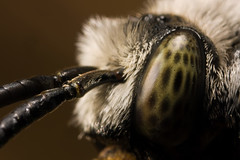This shot at five times life size of a solitary bee is deceptively simple once you know how I took it. First off I have the MT-24EX set to -2/3 FEC and I have the flash heads on the flash mount that Canon supplies with the flash. If you own the MT-24EX then you know that the flash heads make a clicking sound when you move them -there are graduated stops built into the base of the flash heads. I started off by moving both heads all the way down toward the lens and then I brought them back up "one click". I have the heads at that angle for 2x to 5x shooting (two clicks up for life size). Then I turned the flash heads toward each other one click (they were both facing straight out initially). I turned them toward each other because I wanted both heads to pump as much light into the scene as possible and to deepen the shadows. There really isn't anything in that shadowed area in the lower right hand corner of the image, and by letting it fall out I'm making it easier for you to focus on the eyes of the bee. I positioned one flash head at the top of the lens and the other to my left -you can see where they are by the reflections in the bee's eyes.
Since the bee was on rather long plant stem, and was pretty much fully asleep, I could move it around quite a bit. So I positioned it close to the ground with my left had so I could get some of the light from the flash to bounce off of the background and back into the camera to keep the area behind the bee from being completely black. At five times life size the flash is going to fall off quickly so I had to get within a few inches of some grass to get anything to show up in that upper left hand corner.
Now that I'm holding onto the plant stem that the bee is roosting on with my left hand it's a simple matter of resting the lens against that same hand and then slide it to get the focus point where i wanted it. Because of the way the MT-24EX's flash heads were positioned the focusing lamps were useless, but I had enough natural light anyway. See those hairs at the leading edge of the critters eye? That's what I concentrated on when I was focusing the scene. The lenses in the eye aren't easy to see sometimes, but it's easy to tell when those hairs are in focus. Also notice that I'm shooting from an angle that almost puts the eye perpendicular to the lens. Since the plane of sharp focus is also perpendicular to the lens most of the eye is razor sharp. I took four frames at 5x and I refocused for each shot. Of all of them I liked the sharpness and the composition of the image in this post.
I had the camera set to F11, 1/250 (max sync speed for the Canon 40D) and ISO 100. I'm also shooting with a Hoya 81A warming filter. In post all I had to do was run NoiseWare Professional, adjust levels (set a black spot), auto sharpen, and then rub out dust spots with the healing brush before saving the image as a JPG. Not much to post processing because most of it is done before I press the shutter release ;)
Happy shooting!


6 comments:
Macrojunkie -
I owe my latest images to this blog..:)..thanks for the info
Glad it helped Scott :)
Wow, I've somehow only just discovered this blog. Absolutely amazing and inspirational, thank you for sharing.
Thanks nic!
Great Job.
Thanks.
Post a Comment